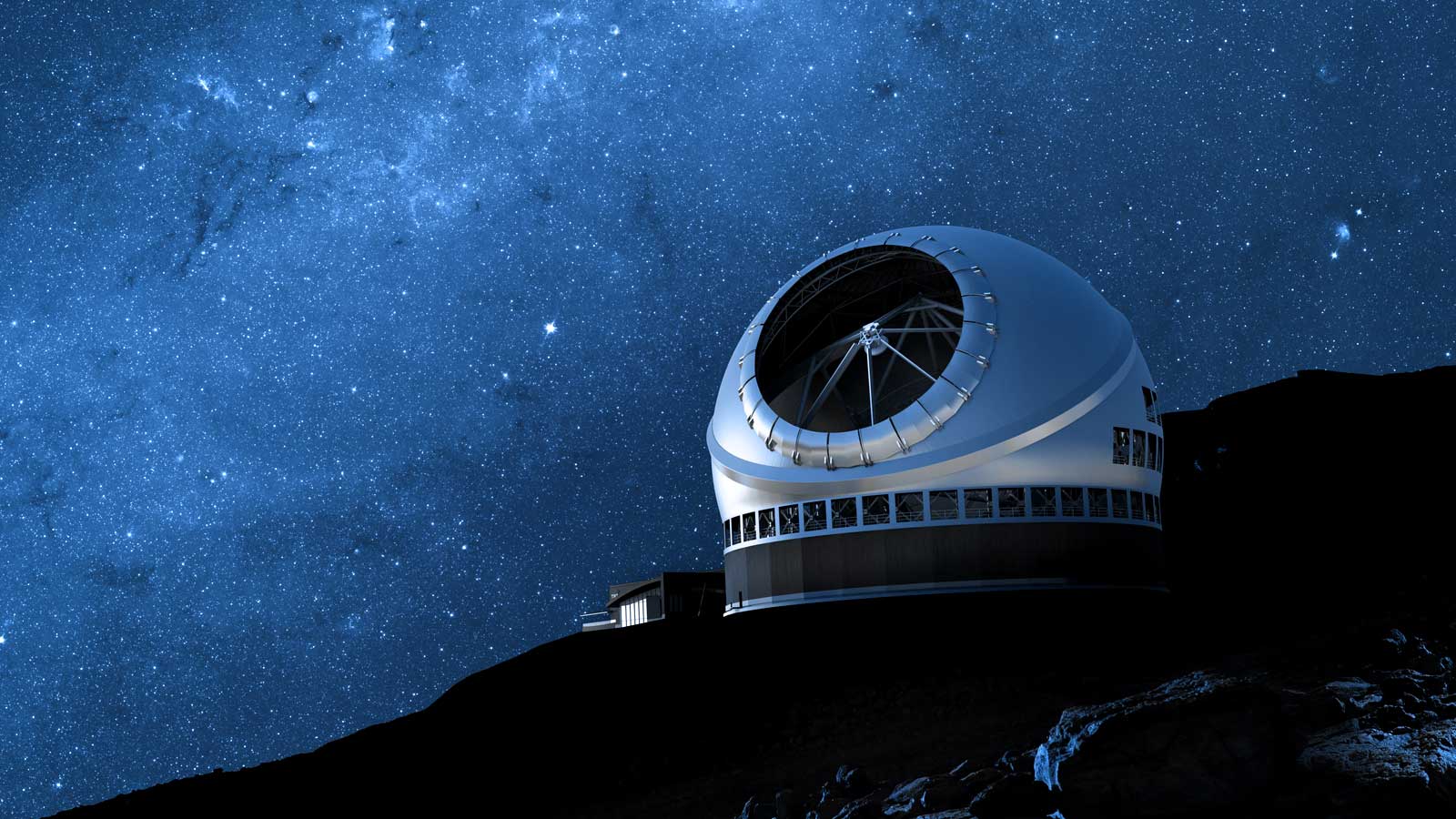
The overlapping observing coverage of the US-ELTP provides US astronomers with unfettered all-sky access from the Giant Magellan Telescope in the Southern Hemisphere and the Thirty Meter Telescope in the Northern Hemisphere. The timezone separation between the sites will increase the system’s capabilities for time-domain astrophysics.
TMT Project Manager Fengchuan Liu and Education, Outreach, and Broader Impacts Manager Yuko Kakazu gave presentations at the International Astronomical Union Asia-Pacific Regional Meeting (APRIM 2023) held from 7–11 August, in Koriyama City, Fukushima Prefecture, Japan.
The Thirty Meter Telescope is shown at a very low elevation angle. The segmented primary mirror reflects the Milky Way and convex secondary mirror. The tertiary mirror in the center of the primary mirror is oriented to send light to the Wide Field Optical Spectrograph, the gray structure located on the right side of the image. The left and right instrument platforms are seen and the dark blue adaptive optics enclosure is seen on the upper left on the instrument support structure.
An illustration for the US Extremely Large Telescope Program (US-ELTP).
A 360-degree rendered panorama of the Thirty Meter Telescope International Observatory can be accessed by copying the following link into your browser: https://app.theviewer.co/xQajzZZxFsJ1iMUq9
Stylized view of the Thirty Meter Telescope with the telescope tube structure suppressed to highlight instruments and the segment handling system. On the far side of the segmented primary mirror is the adaptive optics enclosure in blue that supports the MODHIS First Light instrument on top (also in blue, inside the safety rails). The charcoal colored structure immediately to the left of the adaptive optics system is the telescope optics Alignment and Phasing System (APS). The tertiary mirror in the center of the primary mirror is oriented to send light to the Wide Field Optical Spectrograph, the light gray structure located on the instrument platform on the right foreground of the image. At the rear right is the part of the mirror segment handling system that transfers segments up and down to the observatory floor and on and off the segment handling system above the primary mirror (not shown).
Artist rendering of the completed Thirty Meter Telescope during nighttime deploying lasers for Adaptive Optics towards the Northern Milky Way.
The Thirty Meter Telescope is shown at a very low elevation angle. The segmented primary mirror reflects the convex secondary mirror. The tertiary mirror in the center of the primary mirror is oriented to send light to the Wide Field Optical Spectrograph, the gray structure located on the right side of the image. The left and right instrument platforms are seen and the dark blue adaptive optics enclosure is seen on the upper left on the instrument support structure.
Overview showing WFOIS instrument ...
The Thirty Meter Telescope is shown oriented straight up to the zenith viewed from behind the telescope tube, the telescope tips away to the back of the image to lower elevations. The segmented primary mirror reflects some of the segment handling system and the four mirror cleaning arms can be seen around the circumference of the primary mirror. The two instrument platforms are seen with the light blue adaptive optics enclosure on the platform on the right of the image. Attached to top of the adaptive optics system is the MODHIS instrument on top, shown in dark blue, the IRIS instrument beneath, seen as gray, and on the side port is a commissioning instrument, also shown as gray. The tertiary mirror in the center of the primary mirror is oriented to send light to the Wide Field Optical Spectrograph, the light gray structure located on the instrument platform on the left side of the image. The foreground structure is part of the mirror segment handling system that transfers segments up and down to the observatory floor and on and off the segment handling system above the primary mirror. Segment exchanges take place with the telescope oriented to the zenith.
The Thirty Meter Telescope is shown at an elevation angle of about 45 degrees. The segmented primary mirror reflects some of the telescope’s upper tube structure. The two instrument platforms are seen and the dark blue adaptive optics enclosure is seen in the foreground atop the instrument support structure. Attached to top of the adaptive optics system is the MODHIS instrument on top, shown in dark blue. The charcoal colored structure immediately alongside the adaptive optics system is the telescope optics alignment and phasing system (APS). The tertiary mirror in the center of the primary mirror is oriented to send light to the Wide Field Optical Spectrograph, the gray structure located on the instrument platform to the rear of the image.
Close view of the IRIS instrument attached to the NFIRAOS adaptive optics system. This image shows one of TMT Nasmyth platforms with the IRIS instrument, a first-light adaptive optics fed spectro-imager, attached below the (blue) enclosure of TMT’s adaptive optics facility NFIRAOS. IRIS cable wrap is the circular containment below IRIS, on the floor of the Nasmyth platform. IRIS is attached with supporting rods that are also used to absorb vibrations. The top part of IRIS hosts the instrument wavefront sensors, which work with NFIRAOS to further improve IRIS image quality. Below is attached the cryostat which cools the optical components of the imager (top) and spectrograph (bottom) at -200 deg. Celsius. NFIRAOS can hold up to three instruments and a first-decade AO-fed instrument, which is not yet selected but could be a near-infrared multi-object spectrograph, is seen attached on the side of NFIRAOS enclosure. Two day workers are shown near the instrument to provide a perception of the size of TMT instruments. The ventilation vents are opened and let the air and light enter the inside of TMT enclosure.